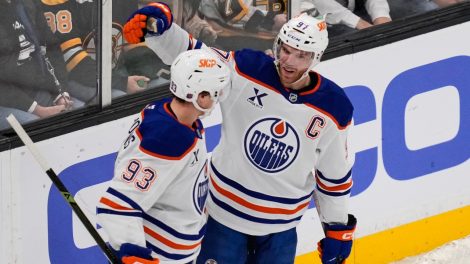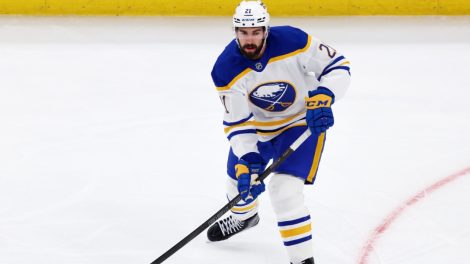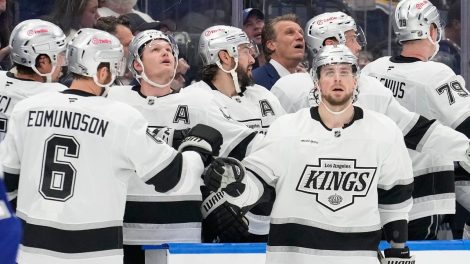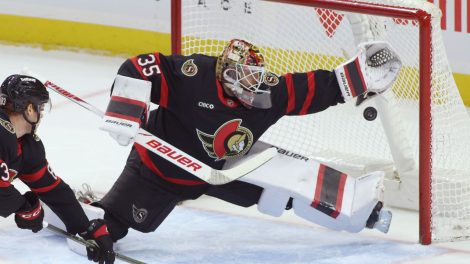The last time the National Hockey League endured such a severe interruption of action — and the inevitable economic sucker-punch that goes with it — the general managers were granted a get-out-of-jail-free card. Two of them, in fact.
In the summer that followed the 2012-13 lockout and truncated season, the players and governors agreed that each club would be permitted two compliance buyouts to help free up salary-cap space in the face of a stagnant cap ceiling. These could be used in the summer of 2013 and/or the summer of 2014, as the cap ceiling waited two seasons to resume its upward trajectory.
With aid of this handy buyout tool, a whopping 28 overpaid players were granted early free agency — on the condition they didn’t re-sign with the same team that bought them out within a full calendar year.
Household names like Martin Havlat, Daniel Briere, Brad Richards, Scott Gomez, Tomas Kaberle, Ilya Bryzgalov and Christian Ehrhoff were among those who had to find new employment.
Is there anything more wonderful than a mulligan?
With the 2020-21 cap expected to take a COVID-19 hit, there are rumblings the league may consider implementing a similar option in the near future — with the NHLPA’s blessing, of course.
And while a throwback to the compliance buyout is purely hypothetical at this stage, we found ourselves with enough time on our hands to sift through the rosters and drum up a list of potential candidates.
[relatedlinks]
Here is a breakdown of 11 players who might be considered for an amnesty buyout, and the pros and cons of pulling the trigger on arguably the most uncomfortable tool at a GM’s disposal.
(For all the nitty-gritty details on buyouts and a handy buyout calculator, head over to the excellent CapFriendly.com.)
 Loui Eriksson, two years at a $6-million cap hit
Loui Eriksson, two years at a $6-million cap hit
In the summer of 2016, Vancouver signed a 30-goal, 63-point stud out of Boston. In four runs as a Canuck, Eriksson has never scored more than 11 goals or 29 points. His slowing feet have also led to an increase in minor penalties and occasional benchings.
That Eriksson’s actual annual salary drops to $4 million in 2020-21 and 2021-22 makes him slightly more tradeable, but the 34-year-old winger is long past his prime — and an exciting Vancouver core is starting to come into its own.
Jim Benning is a spender, and he’s up against it with Roberto Luongo’s cap-recapture penalty and his highest-priced forward under-delivering.
With Jacob Markstrom, Chris Tanev, Josh Leivo, Tyler Toffoli and Jake Virtanen all heading toward free agency, its arguable that a compliance buyout window could help Vancouver more than any other club.
 Justin Abdelkader, three years at a $4.25-million cap hit
Justin Abdelkader, three years at a $4.25-million cap hit
Because the rebuilding Red Wings are in no rush to spend to the cap and assemble an immediate contender, and because they’ll also have a bunch of expensive contracts coming off the books this summer (Jimmy Howard, Jonathan Ericsson, Trevor Daley), they can still absorb overpaid veterans like Abdelkader and Frans Nielsen (two more years at a $5.25-million hit) with ease.
Here’s the question: Does Steve Yzerman still want a 36-year-old Abdelkader taking up cap space in 2023?
It’s easy to look at Abdelkader’s 2019-20 numbers — zero goals, three assists, minus-14 rating — and start dreading another three declining years of overpaying a depth winger.
There could be sentiment at play here, with Abdelkader being a loyal, career-long Wing and a respected leader. But remember this: Yzerman used a compliance buyout on local hero Vincent Lecavalier when he served as Tampa’s GM.
 Brent Seabrook, four years at a $6.875-million cap hit
Brent Seabrook, four years at a $6.875-million cap hit
First, a caveat: Injured players are ineligible for buyouts. Yet Seabrook, 34, seems to be recovering nicely from his three shoulder surgeries, judging by his push-up challenge video (Watch below).
In addition to Alex DeBrincat’s monster raise kicking in for 2020-21, cap-tight Chicago has a few young players in need of a pay bump this summer: Dominik Kubalik, Dylan Strome and Drake Caggiula.
Be it this off-season or next, buying out Seabrook could be an option.
Looks like Brent Seabrook’s recovery is going well, as he’s out here dishing the #PushUpChallenge to @kdach77
(: @kdach77 /IG) pic.twitter.com/ZyNGKZCRyz
— Blackhawks Talk (@NBCSBlackhawks) March 23, 2020
 Milan Lucic, four years at a $6-million cap hit
Milan Lucic, four years at a $6-million cap hit
The underwhelming Lucic has a full no-movement clause until June 1, 2021, at which point it becomes modified. And while last summer’s change of scenery has done both he and James Neal some good, the power forward is nowhere near the $6-million threat he’s getting paid to be.
Lucic, 31, totalled 20 points in 68 games with Calgary and, after a six-year run as a plus, has been a minus player four seasons running.
Considering the Flames’ urgency to contend and GM Brad Treliving’s willingness to buy out mistakes (Troy Brouwer, Michael Stone), Lucic would rank high on a candidates list should the NHL grant compliance buyouts.
#StayAtHomeChallenge thanks @ToreyKrug … @justinbieber in the background (daughter has ‘Never Say Never’ on repeat) pic.twitter.com/6BdhsLpBww
— Milan Lucic (@27MilanLucic) March 21, 2020
 Karl Alzner, two years at a $4.625-million cap hit
Karl Alzner, two years at a $4.625-million cap hit
Although Alzner did work his way back to the NHL for four games this winter, there is no mistaking the defenceman has been a supreme bust, a classic July 1 overpay. In the summer of 2019, he ranked second to Lucic among CapFriendly.com’s most-searched buyouts.
After eight years of perfect NHL attendance, Alzner was scratched on opening night of the 2018-19 season and appeared in just nine big-league games for the organization before being demoted to Laval, where he’s quietly put in solid if overcompensated work for two seasons.
 Andrew Ladd, three years at a $5.5-million cap hit
Andrew Ladd, three years at a $5.5-million cap hit
That Ladd was nearly dealt to Minnesota at the trade deadline in a complicated transaction for Zach Parise is a strong indication of how the organization views the veteran.
Ladd, 34, is just 50 games away from joining the NHL’s 1,000-game club. He did score 11 goals in 34 appearances with AHL Bridgeport this season, and once in his four Islanders games. Perhaps, at a reasonable cap hit, he could play a valuable bottom-six role.
But the Maple Ridge, B.C., native is still making money in line with his 20-goal, 60-point Winnipeg days of 2014-15. And in the coming months, GM Lou Lamoriello is going to add about three zeros to Mathew Barzal’s salary.
 Kyle Okposo, three years at a $6-million cap hit
Kyle Okposo, three years at a $6-million cap hit
A scan of the Sabres’ recent buyout history — Christian Ehrhoff, Ville Leino and Cody Hodgson all had line items this season — is a reminder of the franchise’s love for a good overpay.
God bless Okposo, but the injury-plagued pro has fallen into the same pattern as Matt Moulson: great years next to John Tavares on Long Island, followed by an inability to live up to his contract in Buffalo.
Okposo, 31, is making top-line dollars but put up nine goals and 10 assists in 52 games this season, the fourth consecutive year his point total has dropped.
The Pegulas could also consider a do-over on the Jeff Skinner contract (seven more seasons at a $9-million hit), but the underwhelming winger (14 goals) is only 27 and has a history of up-and-down production.
 Sergei Bobrovsky, six years at a $10-million cap hit
Sergei Bobrovsky, six years at a $10-million cap hit
Buying out the remaining six (!) years of Bobrovsky’s mega-deal would save the cash-conscious Panthers $11 million over the course of the payments. More important: it could correct 2019’s free agency wrong.
No goalie – not even a two-time Vezina champ – should eat up an eight-figure chunk of a team’s salary cap in this era. The position is too unpredictable and too injury- and slump-prone, and the cap space is too valuable.
That Bobrovsky’s 2019-20 record and save percentage (23-19-6, .900) paled next to those his backup, recent ECHLer Chris Driedger (7-2-1, .938), has underscored the danger of betting so big on the position.
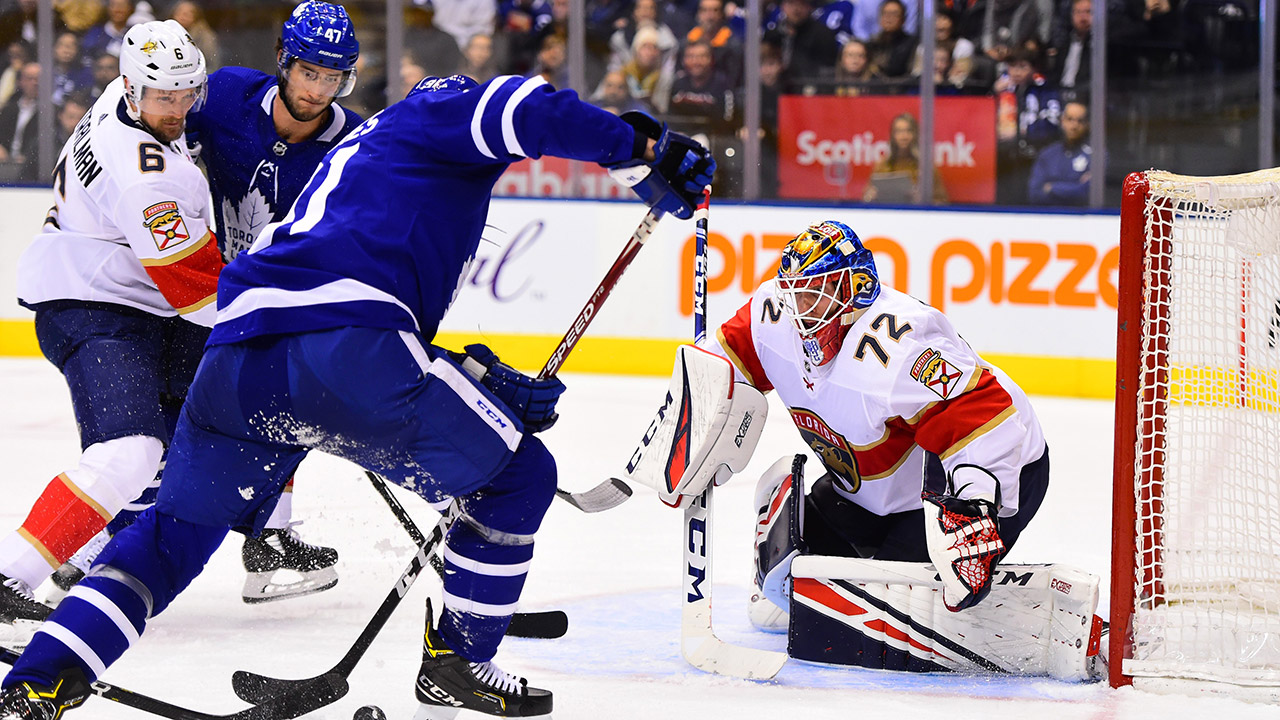
 Henrik Lundqvist, one year at a $8.5-million cap hit
Henrik Lundqvist, one year at a $8.5-million cap hit
This one is more about carving out space than saving money.
When the virus hit pause on the 2019-20 campaign, the Rangers were surging out of their rebuild while awkwardly carrying three NHL-calibre goaltenders. An affordable young duo of Igor Shesterkin and Alexandar Georgiev could set the Blueshirts’ crease up well for years to come.
Buying out the King would bring an unceremonious — and potentially friction-sparking — end to a Hall of Fame career, but it could also be coldly chalked up to the business of sport.
 James Neal, three years at a $5.75-million cap hit
James Neal, three years at a $5.75-million cap hit
No stranger to the buyout as a means to cap comfort, the Oilers are currently paying five players to not be in Edmonton: buyouts Benoit Pouliot, Eric Gryba and Andrej Sekera, plus retained-salary trades Lucic and Sam Gagner.
No doubt, Neal bounced back nicely with 19 goals in 2019-20, but he’s a dash-20 winger on the books until age 35. There are better ways than a power-play specialist to allot that salary during Connor McDavid and Leon Draisaitl’s prime.
Note: Then GM of the Red Wings, Ken Holland used both his amnesty buyouts in 2013 and ’14.
 David Backes, one year at a $6-million cap hit
David Backes, one year at a $6-million cap hit
The urgency to buy out Backes, previously a strain on the Bruins’ cap structure, is not as severe as you might imagine.
The Ducks have a room full of young forwards who could benefit from Backes’s mentorship, work ethic and experience. Further, the guy only has one more season left on his deal, and Anaheim is not expected to be a contender/spender in 2020-21.
Absolutely, Backes is overpaid. He scored once and played a scant 22 games in 2019-20. But he’ll “only” make $4 million in real money next season.


